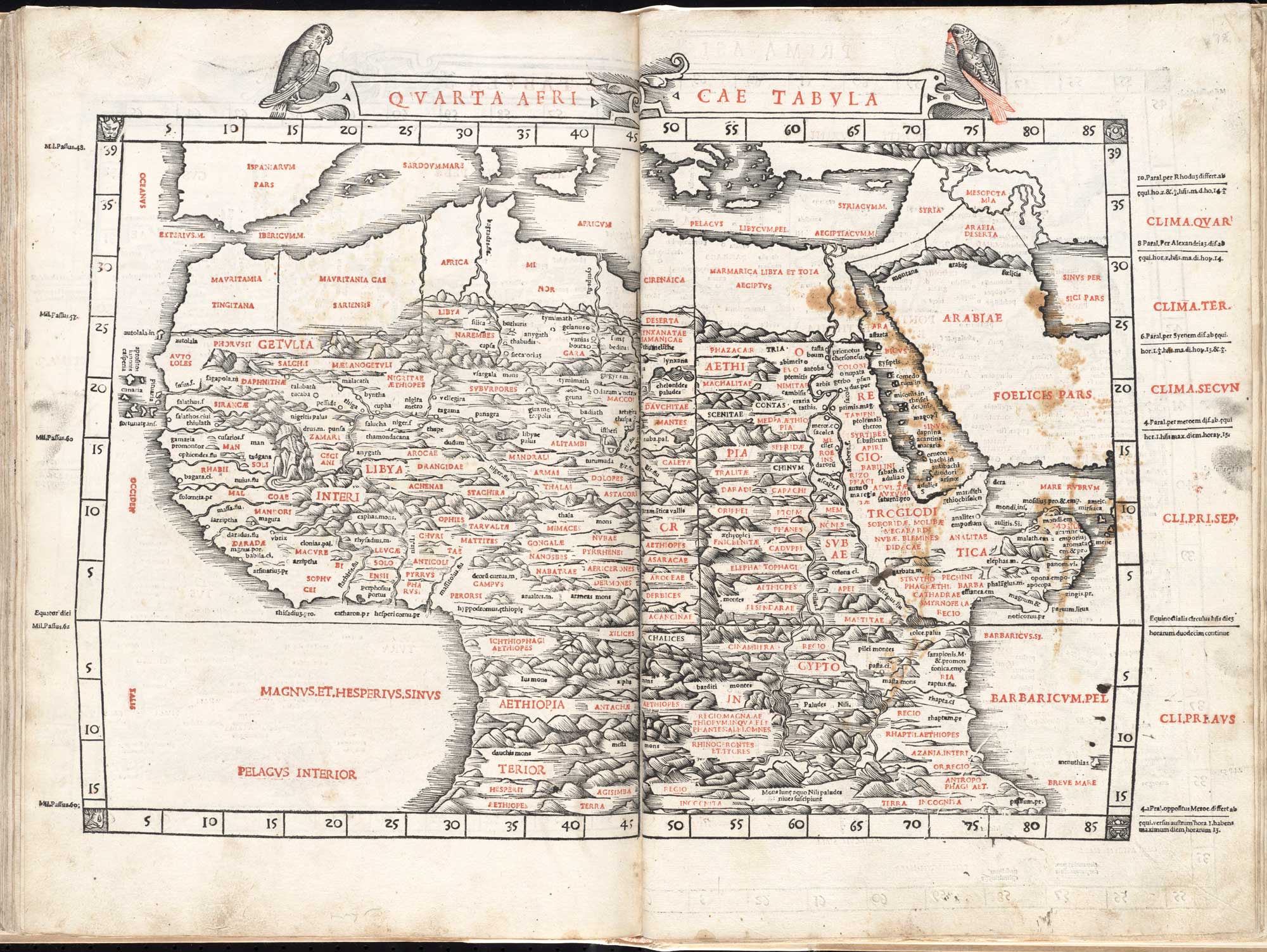and under the climate Dia Cyenes,
Original French: & ſoubs le climat Dia Cyenes,
Modern French: & soubs le climat Dia Cyènes,
Notes
Quarta Africa tabula
Quarta Africa tabula — Paral. per Syenem

Detail showing “Paral. per Syenem”
Syene
At Syene, at Berenice on the Arabian Gulf, and in the country of the Troglodytes, the sun stands in the zenith at the time of the summer solstice, and the longest day has thirteen and one half equinoctial hours; and almost the whole of the Great Bear is also visible in the arctic circle, with the exception of the legs, the tip of the tail, and one of the stars in the square. And the parallel through Syene passes, on the one side, through the country of the Fish-Eaters in Gedrosia, and through India, and, on the other side, through the regions that are almost five thousand stadia south of Cyrene.
Syene
And the distance from the equator to the summer tropic is four sixtieths; and the summer tropic is the parallel drawn through Syene. Now the several distances are computed from the standard measures that are obvious to our senses. The summer tropic, for instance, must pass through Syene, because there, at the time of the summer solstice, the index of the sun-dial does not cast a shadow at noon. And the meridian through Syene is drawn approximately along the course of the Nile from Meroë to Alexandria, and this distance is about ten thousand stadia; and Syene must lie in the centre of that distance; so that the distance from Syene to Meroë is five thousand stadia. And when you have proceeded about three thousand stadia in a straight line south of Meroë, the country is no longer inhabitable on account of the heat, and therefore the parallel through these regions, being the same as that through the Cinnamon-producing Country, must be put down as the limit and the beginning of our inhabited world on the South.
Climat dia Cyenes
Simili modo tradunt in Syene oppido, quod est supra Alexandriam quinque milibus stadiorum, solstiti die medio nullam umbram iaci, puteumque eius experimenti gratia factum totum inluminari, ex quo adparere tum solem illi loco supra verticem esse; quod et in India supra flumen Hypasim fieri tempore eodem Onesicritus scribit
Similarly it is reported that at the town of Syene, 5000 stades South of Alexandria, at noon in midsummer no shadow is cast, and that in a well made for the sake of testing this the light reaches to the bottom, clearly showing that the sun is vertically above that place at the time; and this is stated in the writings of Onesicritus also to occur at the same time in India South of the river Hypasis
Syene
In Syene also just on this side of Aethiopia neither tree nor creature casts a shadow so long as the sun is in the constellation of the Crab.
certain pits in Dalmatia
There are certain pits in Dalmatia , and the country of Cyrene, into which, as some of the ancients relate, if a stone be thrown, a storm will soon after be raised; as if the stone had broke some covering in the place where winds are imprisoned.
Climat Dia Syene
C’est ainsi qu’il faut lire, & non Dia Cicnes, comme on lit dans presque toutes les éditions.
Dia Syenes
C’est ainsi qu’il faut lire, et non Dia Cienes, comme on lit dans presque toutes les éditions. (L.) — Le Duchat lit, comme on voit, Dia Syene; mais nous, nous lisons et nous pensons qu’on doit lire Dia Syenes, pour deux raisons: la première, parceque la préposition grecque διά régit le génitif; la seconde, parcequ’on lit Dia Cyenes, et non Dia Syene ou Dia Cicnes, dans l’édition de 1552 et dans celles de M.D.L. Syene est une ville sur les confins de l’Éthiopie de de l’Égypte, près du Nil.
Dia Cyenes
Près de Syéne, ville de la haute Egypte.
in the Latitude of Syene
Syene (Assouan), on the confines of Ethiopia (Pausanias, viii. 38, § 6). The reading [greek] must be correct. It was believed by the ancient geographers that the latitude of Assouan (24° 5’ 23”) was immediately under the tropic, and that on the day of the summer solstice a vertical shaft cast no shadow there (Pliny ii. 73, § 75). So sous le climat [greek] would mean simply in the latitude of Syene or on the parallel running through Syene. As a geographical term the French word climat means that part of the earth lying between two parallels of latitude. Cf. climat [greek], ii. 13. Martianus Capella (cf. iv. 27, n.18) makes eight climata: Diameroes, Diasyenes, Dialexandreias, Diarrhodu, Diarrhomes, Diahellespontu, Diaborysthenis, Diarrhiphaeon, viii. 876-7.
calida medius [Pompeio] cognitus axis Aegypto atque umbras nusquam decentente Syene
Lucian, ii. 586
Dia Cyenes
Dia Cyenes, ou Dia Syenes, ville d’Égypte; terme géographique emprunté aux Commentarii urbani de Volaterra, Lyon, 1532. (Paul Delaunay)
climat Dia Cyenes
in the region of Assouan, in Egypt.
Dia Cyènes
Ville d’Egypte.
Dia Cyenes
«Le climat Dia Cyenes» (en latin : per Syenem) est, dans la théorie des climats, le second climat: il passe par Syéné, ville de haute Égypte, située exactement sous le tropique du Cancer (voir Pline, II, 73).
Aswan
Aswan is a city in the south of Egypt. Aswan was formerly spelled Assuan or Assouan. Spellings in other languages include Egyptian Arabic: أسوان, romanized: ʾAswān; Ancient Egyptian: Swenett; Coptic: Ⲥⲟⲩⲁⲛ, romanized: Souan; Ancient Greek: Συήνη, romanized: Suēnē. Aswan is the ancient city of Swenett, later known as Syene, which in antiquity was the frontier town of Ancient Egypt facing the south. Swenett is supposed to have derived its name from an Egyptian goddess with the same name. This goddess later was identified as Eileithyia by the Greeks and Lucina by the Romans during their occupation of Ancient Egypt because of the similar association of their goddesses with childbirth, and of which the import is “the opener”.
